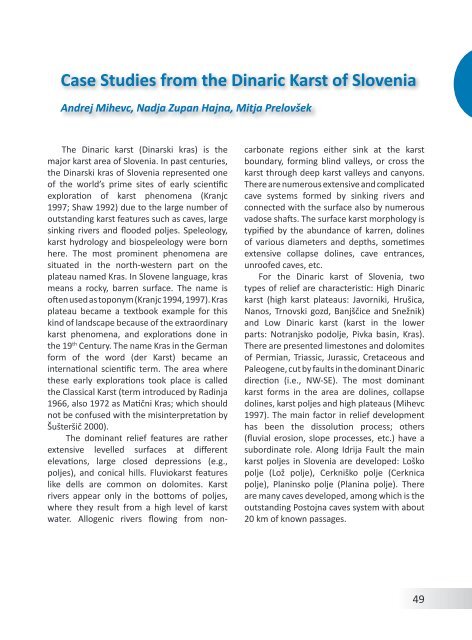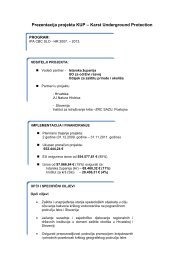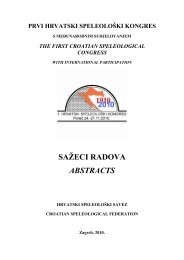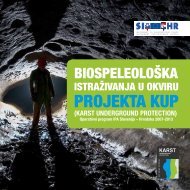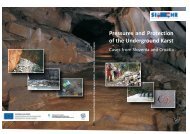Case Studies from the Dinaric Karst of Slovenia
Case Studies from the Dinaric Karst of Slovenia
Case Studies from the Dinaric Karst of Slovenia
You also want an ePaper? Increase the reach of your titles
YUMPU automatically turns print PDFs into web optimized ePapers that Google loves.
<strong>Case</strong> <strong>Studies</strong> <strong>from</strong> <strong>the</strong> <strong>Dinaric</strong> <strong>Karst</strong> <strong>of</strong> <strong>Slovenia</strong>Andrej Mihevc, Nadja Zupan Hajna, Mitja PrelovšekThe <strong>Dinaric</strong> karst (Dinarski kras) is <strong>the</strong>major karst area <strong>of</strong> <strong>Slovenia</strong>. In past centuries,<strong>the</strong> Dinarski kras <strong>of</strong> <strong>Slovenia</strong> represented one<strong>of</strong> <strong>the</strong> world’s prime sites <strong>of</strong> early scientificexploration <strong>of</strong> karst phenomena (Kranjc1997; Shaw 1992) due to <strong>the</strong> large number <strong>of</strong>outstanding karst features such as caves, largesinking rivers and flooded poljes. Speleology,karst hydrology and biospeleology were bornhere. The most prominent phenomena aresituated in <strong>the</strong> north-western part on <strong>the</strong>plateau named Kras. In Slovene language, krasmeans a rocky, barren surface. The name is<strong>of</strong>ten used as toponym (Kranjc 1994, 1997). Krasplateau became a textbook example for thiskind <strong>of</strong> landscape because <strong>of</strong> <strong>the</strong> extraordinarykarst phenomena, and explorations done in<strong>the</strong> 19 th Century. The name Kras in <strong>the</strong> Germanform <strong>of</strong> <strong>the</strong> word (der <strong>Karst</strong>) became aninternational scientific term. The area where<strong>the</strong>se early explorations took place is called<strong>the</strong> Classical <strong>Karst</strong> (term introduced by Radinja1966, also 1972 as Matični Kras; which shouldnot be confused with <strong>the</strong> misinterpretation byŠušteršič 2000).The dominant relief features are ra<strong>the</strong>rextensive levelled surfaces at differentelevations, large closed depressions (e.g.,poljes), and conical hills. Fluviokarst featureslike dells are common on dolomites. <strong>Karst</strong>rivers appear only in <strong>the</strong> bottoms <strong>of</strong> poljes,where <strong>the</strong>y result <strong>from</strong> a high level <strong>of</strong> karstwater. Allogenic rivers flowing <strong>from</strong> noncarbonateregions ei<strong>the</strong>r sink at <strong>the</strong> karstboundary, forming blind valleys, or cross <strong>the</strong>karst through deep karst valleys and canyons.There are numerous extensive and complicatedcave systems formed by sinking rivers andconnected with <strong>the</strong> surface also by numerousvadose shafts. The surface karst morphology istypified by <strong>the</strong> abundance <strong>of</strong> karren, dolines<strong>of</strong> various diameters and depths, sometimesextensive collapse dolines, cave entrances,unro<strong>of</strong>ed caves, etc.For <strong>the</strong> <strong>Dinaric</strong> karst <strong>of</strong> <strong>Slovenia</strong>, twotypes <strong>of</strong> relief are characteristic: High <strong>Dinaric</strong>karst (high karst plateaus: Javorniki, Hrušica,Nanos, Trnovski gozd, Banjščice and Snežnik)and Low <strong>Dinaric</strong> karst (karst in <strong>the</strong> lowerparts: Notranjsko podolje, Pivka basin, Kras).There are presented limestones and dolomites<strong>of</strong> Permian, Triassic, Jurassic, Cretaceous andPaleogene, cut by faults in <strong>the</strong> dominant <strong>Dinaric</strong>direction (i.e., NW-SE). The most dominantkarst forms in <strong>the</strong> area are dolines, collapsedolines, karst poljes and high plateaus (Mihevc1997). The main factor in relief developmenthas been <strong>the</strong> dissolution process; o<strong>the</strong>rs(fluvial erosion, slope processes, etc.) have asubordinate role. Along Idrija Fault <strong>the</strong> mainkarst poljes in <strong>Slovenia</strong> are developed: Loškopolje (Lož polje), Cerkniško polje (Cerknicapolje), Planinsko polje (Planina polje). Thereare many caves developed, among which is <strong>the</strong>outstanding Postojna caves system with about20 km <strong>of</strong> known passages.49


